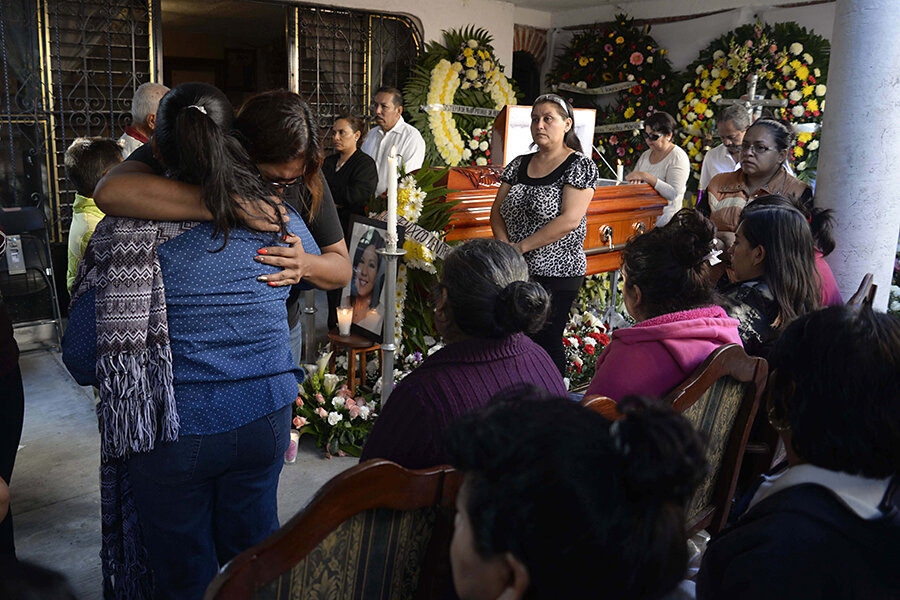Why Mexico's mayors are in cartels' crosshairs
Loading...
| Mexico City
When Mayor Gisela Mota was shot dead in her home Saturday morning, just one day after taking office, she became the latest name on the list of nearly 100 mayors and mayor-elects killed in Mexico over the past ten years.
Organized criminals are believed to be behind the hit. Cuernavaca Bishop Ramón Castro Castro said after a service at Mota’s home Sunday that her death could be seen as a warning to other mayors: “If you don’t cooperate with organized crime, look at what will happen to you.”
While the trafficking of goods and people is often viewed through a national or transnational lens, the targeting of municipal officials like Mota underscores just how deeply rooted these activities are at the local level. Whether it’s growing marijuana, cultivating poppies, shipping illegal goods, or in some cases selling locally, the first obstacle faced by traffickers is often a mayor. And they're largely isolated and unprotected, working with poorly trained and underpaid police forces.
“As a mayor, one way or another, you encroach on someone’s interests,” says Armand Peschard-Sverdrup, senior associate for the Americas program at the Center for Strategic and International Studies. And when a leader looks like he or she may threaten them, these groups take action, whether through intimidation, kidnapping, or murder.
Mayoral vulnerability
With more than 2,000 municipalities across Mexico, both protecting mayors’ safety and ensuring they aren’t aligned with criminal groups is a tall order.
Mota was the first female elected mayor in Temixco, Morelos, a suburb of a picturesque Cuernavaca, about 50 miles south of Mexico City. According to a statement by Mota's political party, she was "a strong and brave woman who on taking office as mayor, declared that her fight against crime would be frontal and direct."
Three suspects were taken into custody after the shooting, one of which told news website SinEmbargo that they were paid 500,000 pesos ($29,000) for the hit.
Taking on a local government position in a region afflicted by organized crime can sometimes require a politician to “look the other way” out of self preservation, says Alejandro Schtulmann, president of Emerging Markets Political Risk Analysis, a consultancy in Mexico City. But in states like Morelos, where multiple gangs are competing for the same territory, the risks go up.
“If you’re a mayor of a small town in Mexico and your town is under dispute by two criminal organizations then you’re going to have to take a side,” Mr. Schtulmann says. “If you don’t want to cooperate with either of them, you are exposed.”
Why even run for mayor?
Given the growing death toll, particularly in states at the heart of organized criminal activity like Michoacán, Guerrero, and Tamaulipas, many question why anyone would want to be mayor in the first place.
“The fact that narcos exist or have domain doesn’t mean that public life is going to end. There are social leaders, party leaders, people with government experience that, despite this violence, want to run for office,” says Pedro Isnardo De la Cruz, an expert in violence prevention and security at the National Autonomous University of Mexico. Plenty are altruistic, hoping to create a change and “thinking they are immune” to the violence or intimidation, he says.
Others may be in the pocket of organized criminals before they even begin to stump. “In Mexico, many go beyond turning a blind eye, to [include] political favors or sometimes intricate relationships with criminal gangs, as exposed by the Iguala case,” Mr. Schtulmann says, referring to a mayor implicated in the disappearance of 43 college students in 2014.
And it's not just suspicions. Evidence emerges periodically showing overt connections between some politicians and criminal gangs. A 2014 video caught three mayors in the troubled southern state of Michoacán having lunch with “La Tuta,” the then-leader of the Knights Templar cartel, for example.
The federal-local balance
Organized crime groups intimidating – or collaborating with – local politicians isn’t a new phenomenon here. In May 2009, then-President Felipe Calderón tried to send a message of zero tolerance when his administration arrested more than 30 state and local officials, including 12 mayors, in Michoacán. But the officials were later released due to a lack of evidence of corruption, with many returning to their posts.
More recently, President Enrique Peña Nieto proposed a plan to combat organized crime and corruption. It included a renewed push for a unified police command model, which involves placing municipal police under state control. Proponents say local governments can be easily intimidated by organized gangs to hand over control of security forces, and that police from outside the community can better stand up to criminal gangs.
Still, state troops aren’t immune to corruption, and the single command approach has come under renewed scrutiny following Mota’s murder. Morelos was an early adopter of the model, moving toward a unified police force in 2012, and yet local leaders are still at risk.
Unified command “is not a solution, but it’s a necessity in front of the weakness of Mexican institutions,” says De la Cruz. “If we don’t advance radically in the professionalization and coordination of police … events like this are going to continue.”








